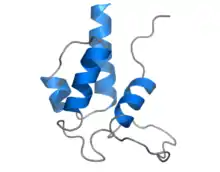Acyl carrier protein
The acyl carrier protein (ACP) is an important component in both fatty acid and polyketide biosynthesis with the growing chain bound during synthesis as a thiol ester at the distal thiol of a 4'-phosphopantetheine moiety. The ACPs are related in structure and mechanism to the peptidyl carrier proteins (PCP) from nonribosomal peptide synthases.[1][2][3][4]
| Acyl/peptidyl carrier protein | |||||||||
|---|---|---|---|---|---|---|---|---|---|
 | |||||||||
| Identifiers | |||||||||
| Symbol | ACP-like_sf | ||||||||
| Pfam | PF00550 | ||||||||
| Pfam clan | CL0314 | ||||||||
| InterPro | IPR036736 | ||||||||
| PROSITE | PDOC00012 | ||||||||
| CATH | 1nq4 | ||||||||
| SCOP2 | 1nq4 / SCOPe / SUPFAM | ||||||||
| |||||||||
The protein is expressed in the inactive apo form and the 4'-phosphopantetheine moiety must be post-translationally attached to a conserved serine residue on the ACP by the action of holo-acyl carrier protein synthase (ACPS), a 4'-phosphopantetheinyl transferase. 4'-Phosphopantetheine is an essential prosthetic group of several acyl carrier proteins involved in pathways of primary and secondary metabolism including the acyl carrier proteins (ACP) of fatty acid synthases, ACPs of polyketide synthases, and peptidyl carrier proteins (PCP) and aryl carrier proteins (ArCP) of nonribosomal peptide synthetases (NRPS). Phosphopantetheine fulfills two demands in these biosynthetic pathways. First, the intermediates remain covalently linked to the synthases (or synthetases) in an energy-rich linkage. Second, the flexibility and length of the phosphopantetheine chain (approximately 2 nm) allows the covalently tethered intermediates to have access to spatially distinct enzyme-active sites. This increases the effective molarity of the intermediate and allows an assembly line-like process.
The ACPs are small negatively charged α-helical bundle proteins with a high degree of structural and amino acid similarity. The structures of a number of acyl carrier proteins have been solved using various NMR and crystallography techniques.
References
- Roujeinikova A, Baldock C, Simon WJ, Gilroy J, Baker PJ, Stuitje AR, Rice DW, Slabas AR, Rafferty JB (June 2002). "X-ray crystallographic studies on butyryl-ACP reveal flexibility of the structure around a putative acyl chain binding site". Structure. London, England : 1993. 10 (6): 825–35. doi:10.1016/s0969-2126(02)00775-x. PMID 12057197.CS1 maint: location (link)
- Crawford JM, Vagstad AL, Ehrlich KC, Udwary DW, Townsend CA (July 2008). "Acyl-carrier protein-phosphopantetheinyltransferase partnerships in fungal fatty acid synthases". Chembiochem : a European Journal of Chemical Biology. 9 (10): 1559–63. doi:10.1002/cbic.200700659. PMC 3189688. PMID 18551496.
- Volkman BF, Zhang Q, Debabov DV, Rivera E, Kresheck GC, Neuhaus FC (July 2001). "Biosynthesis of D-alanyl-lipoteichoic acid: the tertiary structure of apo-D-alanyl carrier protein". Biochemistry. 40 (27): 7964–72. PMID 11434765.
- Weber T, Baumgartner R, Renner C, Marahiel MA, Holak TA (April 2000). "Solution structure of PCP, a prototype for the peptidyl carrier domains of modular peptide synthetases". Structure (London, England : 1993). 8 (4): 407–18. doi:10.1016/s0969-2126(00)00120-9. PMID 10801488.
External links
- Acyl Carrier Protein at the US National Library of Medicine Medical Subject Headings (MeSH)